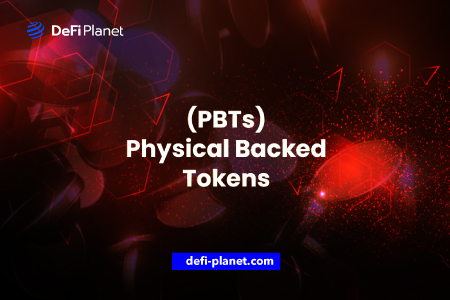Azuki has introduced its Physical Backed Token (PBT) as a new way of verifying the authenticity of physical objects in the blockchain space. This new technology enables users to connect tangible objects to the Ethereum blockchain.
An automatically generated asymmetric key pair connects a “Bean Chip” to the PBT token standard. Users can then scan the chip with a smartphone to link the various parts to a single wallet. The technology, powered by an open-source protocol, allows anyone, at any time, to adhere to Azuki’s PBT specification.
With this new approach, unlike competing products, all transactions are processed in a decentralized manner on the blockchain itself, eliminating the need for a middleman. This article will explore what Azuki’s Physical Backed Token is and the role it plays in the future of NFTs and Web3.
An Overview of Asset-Backed Tokens
Asset-backed tokens, such as the PBT, are digital representations of ownership rights to a real-world asset, such as gold, real estate, or crude oil. They are created using blockchain technology, allowing them to be traded between peers without the involvement of a financial institution.
Asset-backed tokens have grown in popularity since the advent of blockchain technology. Bitcoin was the first token, but unlike gold or silver, it has no physical backing. Since Bitcoin was launched, thousands of distinct cryptocurrencies and stablecoins pegged to fiat currency have emerged.
Asset-backed tokens are designed to store value and be traded between peers without a financial institution acting as a middleman. Despite the volatility of cryptocurrencies, their development has been spurred by the cryptocurrency revolution.
Financial authorities often classify asset-backed tokens as securities because their value is tied to the value of the underlying asset. This means that the token owner has the same rights as the asset owner and, depending on the asset, may be entitled to a return if the asset increases in value. The value of the token rises in tandem with that of the underlying asset.
In addition to being a way to store value, asset-backed tokens can also be used as a new equity instrument for fundraising. This means that a person, company, or other entity can offer the token in exchange for investment and raise funds through a blockchain-based system.
Businesses may also choose to tokenize and sell existing assets, providing individuals with the opportunity to invest in real-world assets without the hassle of storing or exchanging physical assets. This can lead to less tension in international trade and fewer expenses associated with transporting goods. Transactions involving asset-backed tokens are generally cheaper, more secure, and faster than those involving traditional methods.
Furthermore, asset-backed tokens provide individuals with a viable new financial option that combines digital liquidity with hard asset values when necessary, mitigating the effects of inflated or devalued currencies as well as the volatile stock market.
What is PBT (Physical Backed Token)?
Physical Backed Token is the latest Ethereum token standard built on top of the ERC721 protocol. It establishes a connection between a physical item and a virtual token.
Essentially, they are non-fungible tokens (NFTs) backed by physical assets. These physical items are encoded with NFT data and sold to the public, but the problem with this system is that after the initial FOMO wears off, there is often little connection between the NFT and the actual physical item it represents.
PBTs seek to address this issue by assigning a unique “Bean Chip” to each physical item that is used as collateral for a PBT. In addition to the NFT representation of the item, the Bean Chip also stores a key. When users use their mobile device to scan an item with a Bean Chip, the NFT is instantly created and sent to their crypto/NFT wallet.
This means that owning a single NFT is the same as owning the physical item it represents, making it easier for the two to work together and ensure the item’s authenticity while maintaining decentralization.
Features of PBT
Decentralized
Unlike conventional authentication methods that rely on server centralization, PBT does not require this. Its new authentication standard eliminates the need for a central authority by using an asymmetric public-private key pair on a self-attesting chip.
Extensible
PBT takes a neutral stance on the content that is created in it. It can be used in many ways to add to an experience, such as by accessing digital content, going on physical quests, or trading authenticated items.
Open Source
PBT is open source, which means anyone can use and modify it in any way they see fit.
Trustless
Since it is a token standard on Ethereum, anyone can independently authenticate and verify items and ownership, as well as build experiences on top of the underlying technology.
How Does Azuki’s Physical Backed Token (PBT) Work?
The Physical Backed Token (PBT) is a significant development for the Azuki project. Previously, after minting a token to represent a physical asset on a blockchain, the token and the asset were kept entirely separate. This resulted in two major challenges associated with the digital representation of physical assets:
- Non-Fungible Tokens (NFTs) could not stand in for the underlying assets they were supposed to represent. Currently, NFTs and tangible items are treated separately, with NFTs for physical items able to be traded on online marketplaces.
- Physical assets could only be verified as NFTs through additional steps, requiring third-party sources to confirm the item’s authenticity.
PBT addresses these issues through its on-chain NFT ownership tracking and decentralized asset authentication model. The “BEAN” chip embedded in the physical asset of a PBT facilitates the verification of NFT ownership.
The PBT standard itself is useful for distributed ledger systems to keep track of ownership. The “scan-to-own” process allows sellers of physical items to facilitate the sale of those items by enabling buyers to obtain PBTs by scanning the physical asset.
The Bean Chip is a crucial component of PBT, enabling the “scan-to-own” experience. This chip is built on the blockchain and generates its asymmetric key pair. Users with access to a physical token can create new tokens or move existing tokens to other wallets by scanning the embedded chip.
In this case, the PBT serves as a direct link between the token and the physical item, with the token also being stored in the owner’s preferred cryptocurrency wallet. This makes PBTs legally transferable to the owners of the physical items they represent.
How Do PBTs Benefit Creators?
Creators and brands can now provide their audiences with a genuinely cutting-edge experience with the help of PBTs.
The PBT also connects the assigned physical item to its NFT throughout its lifetime. Collectors can now participate in real-world and virtual adventures by purchasing PBT-backed items.
Use Cases of PBTs
Physical Backed Tokens can currently be used for the following:
Authenticating physical items without a central authority
A smartphone’s camera can be used to verify the authenticity of a product.
Determining the ownership lineage of physical items
PBT allows brands to build product experiences for their audiences. It also allows them to track the ownership lineage of physical items.
Using of physical items to creating digital experiences
With PBT, users can use a physical item to gain access to digital content.
In Conclusion
- PBTs provide the foundation for new experiences. PBT holders can participate in real-world quests, trade authenticated items, and create a collection that spans both the digital and physical worlds.
- Using PBTs can simplify the representation and transfer of physical assets. The ability to track the lineage of a physical item in a decentralized manner adds to the trust in the PBT ecosystem.
- These benefits can not only drive the expansion of PBTs but also serve as standards for a variety of future endeavours. With Azuki’s long-term vision in mind, we hope that PBTs will be used for other purposes in the near and distant future.
If you would like to read more articles like this, visit DeFi Planet and follow us on Twitter, LinkedIn, Facebook, and Instagram.
“Take control of your crypto portfolio with MARKETS PRO, DeFi Planet’s suite of analytics tools.”





















